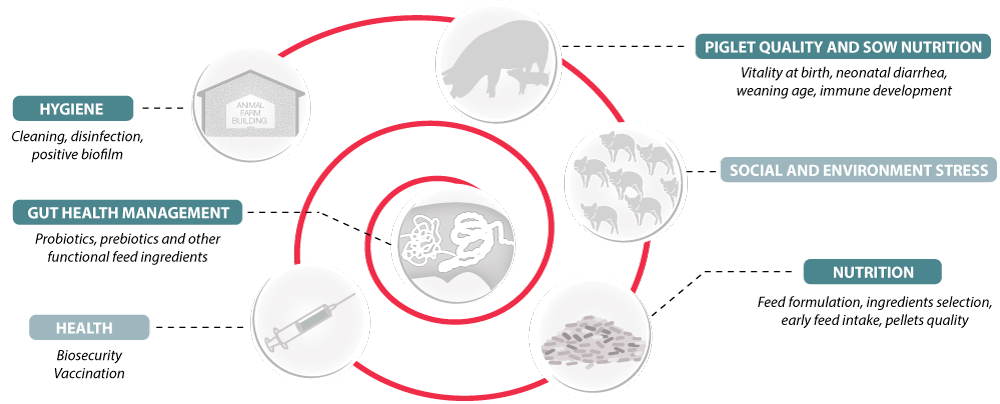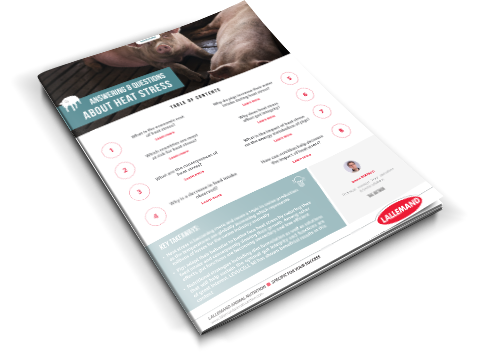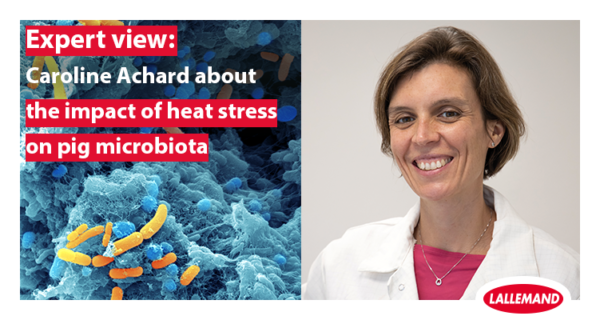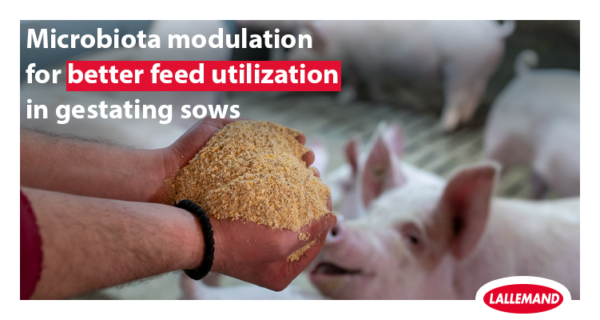Blog | Reading Time 8 minutes
An outside-in approach to piglet management under reduced antibiotic and zinc oxide use
In the actual context of reducing medication practices due to public health concerns, swine specialists are considering alternative management strategies to help reduce the use of antibiotics and zinc oxide while safeguarding post-weaning performance. We know there is no silver bullet to address this and the best option is to take a wider look at the whole production cycle and take a multi-factorial approach to piglet management, involving not only piglet nutrition but also the sow and the animal environment. As such, the application of complementary and scientifically documented microbial products such as active and inactive yeasts and bacteria show benefits within a holistic approach of the weaning period. Together they constitute an outside-in approach that can help mitigate the piglet’s post-weaning challenges within the context of reducing the use of antibiotics and zinc oxide.
The vicious cycle of post-weaning gut disorders
Weaning is a crucial transition frequently associated with enteric disorders. Post-weaning diarrhea mostly occurs within two weeks after weaning and is associated with a significant increase in mortality and body weight losses. Mortalities commonly range from 1.5% to 2% but can reach 25% over one to two months in severe circumstances. In addition, the reduced feed intake observed during this period is responsible for a low growth rate.
Likely induced by an impaired appetite in a context of digestive and immune immaturity, the biological mechanisms involved in the development of diarrhea include multiple factors affecting gut morphology, microbiota balance (dysbiosis), and digestive inflammatory status. This chain of events is considered a vicious cycle that leads to post-weaning diarrhea and performance losses.
An outside-in approach
Along with the need to reduce the use of antibiotics and zinc oxide, to help piglets cope with this vicious cycle, farm management objectives should consider:
- Limiting exposure to pathogens from the environment
- Strengthening gut functions (barrier, digestion)
- Optimizing nutrient retention (accessibility, digestibility, kinetic digestion, anti-nutritional factors, growth factors).
To address this multifactorial challenge, the latest developments in swine production suggest a holistic approach combining environmental, nutritional, piglet quality, and gut health strategies (Figure 1).
Swine experts at Lallemand Animal Nutrition have developed a range of complementary and scientifically proven microbial solutions to help address environmental and nutritional needs of the post-weaning piglet in a context of reduced use of antibiotics and pharmacological doses of zinc oxide.
Control external microbial pressure
First of all, biosecurity measures should be taken to prevent the entrance of pathogens on the farm. Pay particular attention to people, vehicles, rodents, birds, domestic animals, routes of transmission, piglet origin, feed, water hygiene, etc.
Other measures should be taken inside the farm to avoid the spread of any disease or potential pathogenic agent. It should include procedures of cleaning and disinfection but also the establishment of a microbial positive biofilm on barn surfaces as an innovative internal biosecurity solution. The positive biofilm solution LALFILM PRO combines selected bacteria to install a positive biofilm on farm building surfaces. It will help limit the implementation of future potential undesirable bacteria on surfaces as negative biofilm in the piglet environment from the farrowing to the post-weaning rooms. It can help maintain a positive microbiological and safe environment for animals.
In addition, the piglet’s health must be secured with a comprehensive life cycle vaccination program prescribed by the farm’s veterinarian.
Finally, pay attention to ambient temperatures and feeding space. These actions help reduce social and environmental stresses.
Improve piglet quality
To raise piglets well-equipped to cope with this challenging transition, parameters such as weaning age, and weight can be adjusted. The former can be managed with early attention to sow’s farrowing conditions in order to improve piglets’ vitality at birth and thus the colostrum intake.
The modulation of the sow digestive microbiota is one of the drivers to help reduce the incidence of neonatal diarrheas. Indeed, at birth and during lactation, maternal microbial imprinting contributes to offspring microbiota establishment and exerts a long-lasting influence on animal health and performance, even after weaning (Achard et al., 2019).
Supplementation of gestating and lactating sow diets with the well-documented probiotic yeast Saccharomyces cerevisiae boulardii CNCM I-1079 (LEVUCELL SB) has been shown to modulate the sow’s microbial profile, subsequently affecting piglet microbial profile and performance at weaning.
Stimulate early feed intake
Before weaning, it is possible to stimulate solid feed intake and reduce anorexia consequences by offering creep feed to suckling piglets (Huting et al., 2021).
After weaning, consider dietary ingredients with enhanced palatability properties, such as flavors and functional yeast proteins to help stimulate feed intake. Trial in post-weaning piglet has shown a 17% increased feed intake during the first-week post-weaning with a specific hydrolyzed yeast in the diet (YELA PROSECURE).
Feed presentation is also important. Pay attention to feed technological quality to optimize feed intake. For example, monitor criteria such as pellet diameter, hardness, particle size, etc.
Select nutrients for digestibility and quality
When piglets start eating dry feed, nutrients arriving in the immature intestinal environment are not absorbed in an optimal way. Some of these nutrients reach the hindgut and undergo proteolytic fermentation. Feed formulations should target highly digestible nutrients for optimal absorption.
Precision feeding practices should consider fiber profiles (insoluble/soluble NSP), protein levels for balanced and highly digestible sources, and mineral compounds that may increase the feed buffering capacity (Pluske et al., 2018) (Figure 2).

Figure 2: Nutritional points of attention in an antibiotic and zinc oxide reduction context (Adapted from Pluske et al., 2018)
Along with benefits to feed palatability, the use of functional yeast proteins with fast kinetic absorption can help limit the risk of proteolytic fermentation in the hindgut. For example, the functional hydrolyzed yeast protein YELA PROSECURE represents a source of free amino acids and small peptides that helps to stimulate feed intake.
Support a healthy intestinal ecosystem
Poor intake results in suboptimal levels of nutrients for normal intestinal development. Likewise, it translates into limited substrates for the endogenous microbial populations and affects the microbial digestive composition.
In turn, a reduction of beneficial bacteria, resulting in substantial consequences for digestion, is generally observed. Gresse et al., 2017 reported a decrease in members from the Lactobacillus genus in the gut of piglets at two to three days after weaning.
Lactobacillus are key players in carbohydrate degradation, contributing to the maintenance of the gut pH gradient and limiting the growth of other bacterial species. Gresse (2017) also reported that Clostridium spp., Prevotella spp., and E. coli were found in a higher abundance in the gut microbiota of weanlings.
The gut epithelium is the first line of defense for the organism. An impaired barrier, combined with the pH increase, are favorable factors to the proliferation of pathogenic bacteria able to cross it and activate some inflammatory responses.
Gut health management at weaning should then support a normal gut structure and microbiota composition while limiting inflammatory status.
Finally, preventive action at favoring a healthy intestinal ecosystem is synergistic to immune modulation and direct binding action against pathogen overgrowth. Here, the innovative association of synergistic inactivated yeast fractions YANG has shown benefits in weaning piglets. It has strong undesirable bacteria binding and broad immune modulation properties. It adheres to E. coli fimbriae, helping to reduce post-weaning diarrhea incidence and improve growth performance.
Conclusion
The post-weaning period is a critical phase of pig production. At weaning, piglets face several common digestive disorders affecting performance. Post-weaning diarrhea and higher mortality rates are the most serious consequences during this time frame, with negative outcomes on production performances.
A successful post-weaning phase should rely on a holistic approach combining good management (biosecurity, hygiene, etc.) and precision feeding practices. Feeding functional ingredients that can help support gut health is essential when targeting the reduction of antibiotics and zinc oxide.
Thanks to its expertise in microbial-based solutions, Lallemand Animal Nutrition offers complimentary tools to phase out this situation with simultaneous actions through the diet and the environment.
Download our white paper ‘From the outside-in: Microbial-based solutions help manage piglets under reduced antibiotic and zinc oxide use’ to go further!
Published Jan 23, 2022 | Updated Jul 4, 2023




